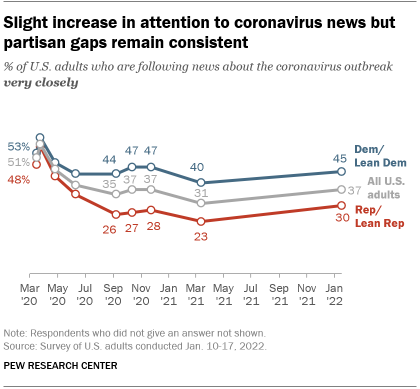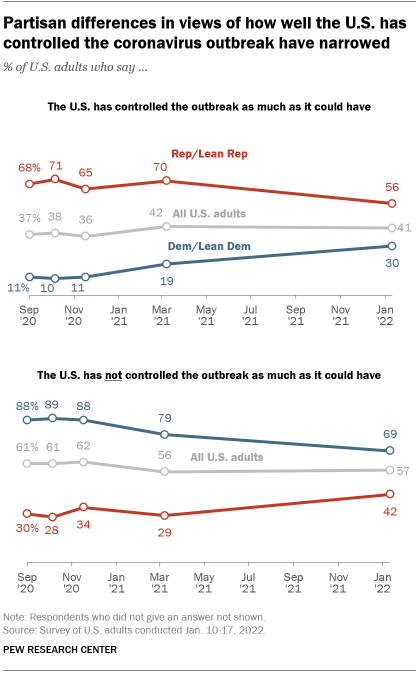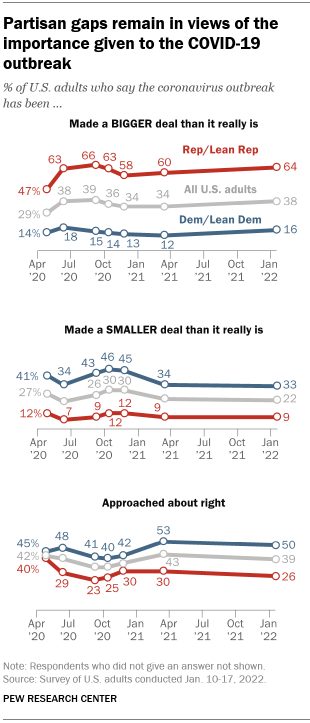The percentage of Americans who follow COVID-19 news very closely has increased slightly since March 2021, the last time this question was asked, according to a Pew Research Center survey conducted Jan. 10-17, 2022. The survey also found that large partisan gaps remain in attention to and views about the pandemic.
Overall, 37% of U.S. adults say they are following news about the coronavirus outbreak very closely. That is up from 31% in March 2021 and back to the level of interest seen in fall and winter of 2020 – a time when cases were increasing, businesses faced closures and many schools returned to virtual learning.
In late March 2020, during the early stages of the outbreak, over half of all Americans (57%) were following news about the coronavirus very closely, a percentage that marked the high point in public attention. Earlier in the month, 51% of U.S. adults said the same.
Over the past two years, Pew Research Center has tracked Americans’ views on the COVID-19 pandemic. This survey sought to measure how much attention the public has paid to it over time, their assessment of how it was handled and whether they believe it was made into a bigger deal or smaller deal than it really is.
For this recent survey, 5,128 U.S. adults were surveyed from Jan. 10-17, 2022. Everyone who took part is a member of the Center’s American Trends Panel (ATP), an online survey panel that is recruited through national, random sampling of residential addresses. This way nearly all U.S. adults have a chance of selection. The survey is weighted to be representative of the U.S. adult population by gender, race, ethnicity, partisan affiliation, education and other categories. Read more about the ATP’s methodology.
Here are the questions used for the report, along with responses, and its methodology.
This is the latest report in Pew Research Center’s ongoing investigation of the state of news, information and journalism in the digital age, a research program funded by The Pew Charitable Trusts, with generous support from the John S. and James L. Knight Foundation.
One finding that has remained fairly steady since late 2020 is that Democrats and those who lean toward the Democratic Party are much more likely than Republicans and Republican leaners to say they follow news about the outbreak very closely. According to the new survey, 45% of Democrats are paying very close attention to news of the outbreak compared with 30% of Republicans, both slight increases from March 2021. That party divide was not seen early in the pandemic, but it emerged in the summer of 2020 and has been the case since.
Shifts on both sides of the political aisle in views about how well the U.S. has controlled the outbreak
One key COVID-19 issue that has produced a strong partisan divide is whether the United States has or has not controlled the coronavirus outbreak as much as it could have.
Since the question was first asked in September 2020, Republicans have been far more likely than Democrats to say it has been controlled as much as it could have. While that is still the case, the gap between the two has narrowed, with Republicans becoming less likely to hold this view and Democrats more likely.
As of January, 41% of the public overall says the outbreak has been controlled as much as possible, about equal with the 42% who held this view last March. Within those numbers, though, are large shifts on both sides of the political aisle. Currently, 56% of Republicans say the U.S. has controlled the outbreak as much as it could have. While still a majority, this is down from 70% in March 2021. Democrats, on the other hand, have become more likely to hold this view: 30% now feel this way, up from 19% in March.
There was less partisan movement on the question of whether the coronavirus outbreak has been made into a bigger deal or smaller deal than it really is, or if attention to it was about right. Roughly four-in-ten U.S. adults (39%) now say the pandemic has received about the right amount of attention. About the same portion (38%) say it has been made into a bigger deal, and 22% say it has been made into a smaller deal – numbers that have remained fairly steady since September 2020.
The large partisan differences on this question have also shifted very little. Four times as many Republicans (64%) as Democrats (16%) now say the pandemic has been exaggerated. At the same time, Democrats are almost four times as likely as Republicans (33% vs. 9%) to say it has been downplayed.
Finally, Democrats remain more likely than Republicans to discuss the COVID-19 outbreak with others. A sizable portion of Democrats (45%) say they discuss the outbreak with others almost all or most of the time, versus 28% of Republicans. Conversely, Republicans are about twice as likely as Democrats to say they hardly ever or never discuss it (21% vs. 11%). The remaining 51% of Republicans and 44% of Democrats say they sometimes discuss the outbreak with others.
Followers of both parties are less likely now than in April 2020 to say they discuss the pandemic almost all or some of the time. The share of Democrats who say this fell 5 percentage points from 50% in 2020 to 45% in the new survey, while the share of Republicans dropped 11 points, from 39% to 28%.
Note: Here are the questions used for the report, along with responses, and its methodology.




